How would you feel, after carrying out SEO techniques over a considerable time, your website still rocks bottom of guaranteed search engine rankings while your competitors keeps dominating the first Search Engine Result Page(SERP)?
What kind of “magic” are they(your competitors) doing that keeps them in that first page, year in year out.
It boils down to only one solution;
SERP Analysis.
What exactly do i mean by serp analysis?
It is the process of scrutinizing top ranking competitor websites, uncovering the strategies they use and capitalizing on them with purpose of achieving same search engine results as theirs and even outranking them.
Hence, in this article, we will do step by step SERP Analysis of our competitors to get guaranteed top search engine rankings for your relevant keywords(you wish to rank for).
To understand this process better, we will be using a case-study as an example with the aid of a special SERP analysis tool.
So, without any time delay, lets hit the ground running.
SPECIAL NOTE: If you don’t have much time to read, feel free to click on any of these category topics that interests you for quick access.
How to do SERP analysis for guaranteed search engine rankings
To begin with, we will carry out the following steps such as
- Do Keyword Research
- Analyze Search Intent
- Analyze your Competitors
- Explore ranking opportunities
- Carry out content optimization
The tool we will be using here is Semrush which offers a 7-day free trial for fresh users .
Below is an overview of how the tool looks like;
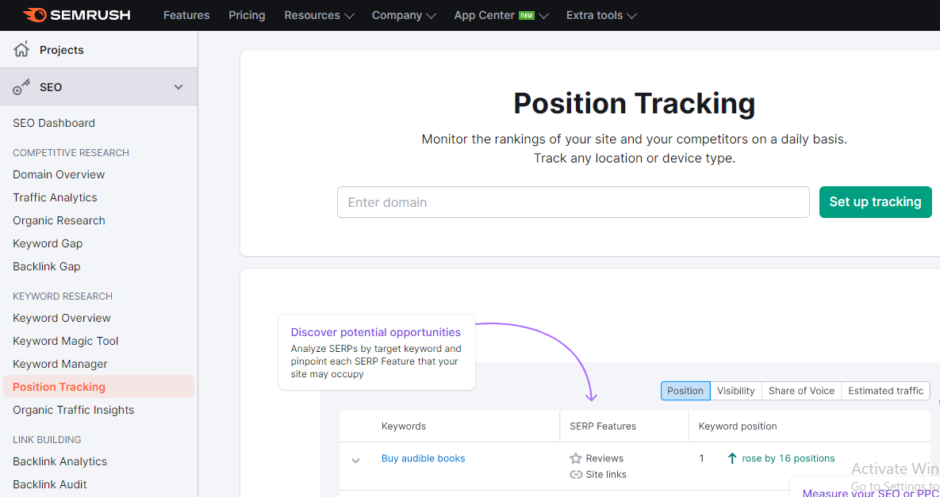
CASE-STUDY EXAMPLE
We will be using this particular keyword: Blogger outreach strategy .
Below is the image showing overview analysis of our case-study keyword: blogger outreach strategy
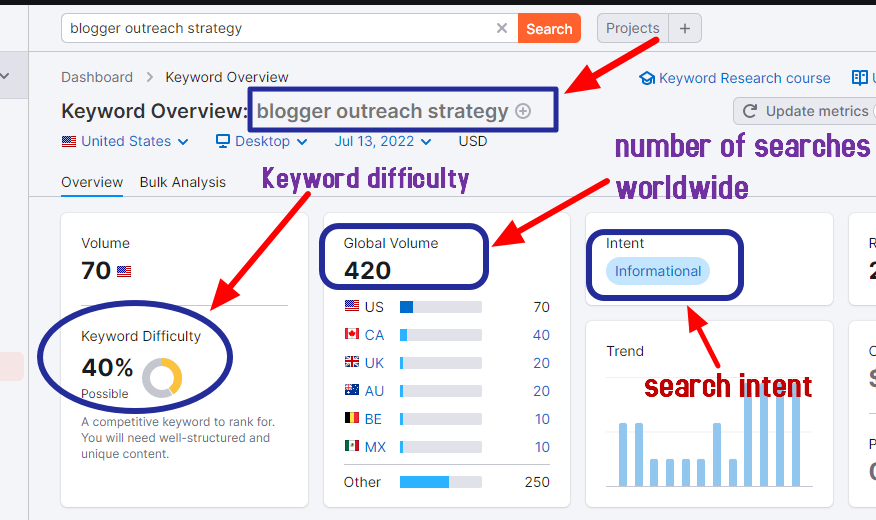
Lets get back to the steps
Do Intense Keyword Research
First of all, you need to ask yourself.
– what is the nature of your keyword?
– what type of keyword are you targeting?
– what is the keyword difficulty(KD) of your target keyword?
– How competitive is your keyword?
Lets expatiate on them one-by-one;
Nature of your keyword
Is your keyword short, medium or long tail?
Most short tail keywords, though they command a huge search volume, are strongly dominated by high domain authority websites hence it will be almost impossible to beat them for these forms of keywords.
Question: So what do you do here?
Answer: We recommend you go for long-tail keywords because of the following 2 reasons;
- first, they are much easier to rank for than medium/long-tail keywords
- second, they convert better meaning your chances of getting conversions e.g. sales, clicks, visits etc. are higher.
What type of keywords are you targeting
First, Does your keywords fall into any of these category;
- informational: these keywords are for people seeking information where necessary e.g. where is Whitehouse located, difference between trainers and canvas, Euro 2018 teams, profitable niches with low competition etc.
- transactional: These keywords are used by those who intend to make transactions now or later. e.g. buy cryptocurrency online, Toyota cars for hire,
- navigational: is your keyword intended to locate a webpage or website e.g. Netflix, Birmingham university etc.
- commercial: These are for those seeking information about specific products and services. e.g. Nike footwear, infinix note 12 reviews, ubersuggest vs ahrefs etc.
You can use semrush tool to find out the keyword type as i have done for “Birmingham university” and “buy cryptocurrency online” under the keyword overview option

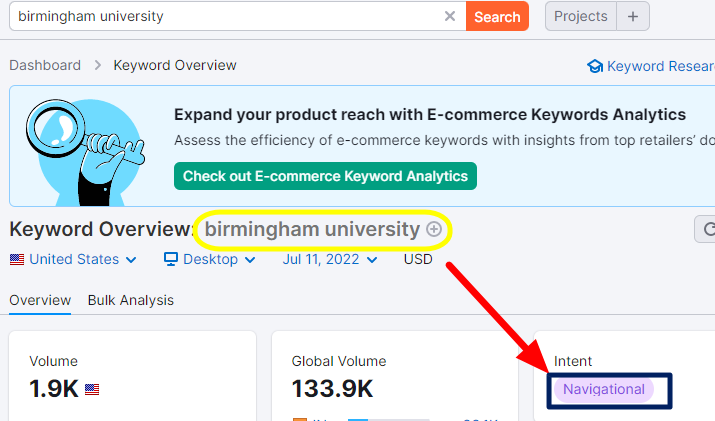
Question: Now, why is this necessary?
Answer: So you know the nature of keywords to fabricate and what actions to expect from visitors traffic.
If you are into selling of Chelsea club jerseys, you CANNOT expect customers to patronize you if your target keywords are Chelsea club history, which jerseys is best, Chelsea jersey evolution etc.
What is your keyword difficulty
Keyword difficulty score tells us how difficult it is for such keyword to rank among its competitors.
it varies from 1-100 and expressed in percentage. The lower the score, the easier it is to rank high on SERP results.
From our case-study keyword shown above, you can see that its KD score is 40% which is very OK
Also check out this keyword difficulty score for Toyota Camry model car.

Question: why check out its difficulty level?
Answer: So you wont waste time choosing keywords(used by big authority websites) that are practically impossible to rank for. Go for keywords that are of KD 50 and below.
How competitive is your keyword?
There are 2 ways to check this out.
- first, through its keyword difficulty.
- second, the nature of websites ranking on the first page of your keyword query SERP results
On the first one, this has been explained above already. The lower the Keyword density(KD) of a keyword, the less competitive and easier it is to rank high for.
On the second one, when i say nature, i mean these: how strong are the websites are?, are they of high domain authority or not?, are they paid ads or organic search results?, are they authorities in their niche? etc.
One way to check these features out is to install a browser extension tool called keywordeverywhere in your Mozilla“ or google chrome browser.
After installation, do a google search of our case-study keyword with a browser and you will see similar image as this below which is our case-study image;

Using the keyword: blogger outreach strategy as our case-study, we can deduce these following from this search results in the image above about the keyword;
- Number of search results: we can see that the number of websites competing for the keyword is 23,900,000, meaning it is on a moderate level.
- Domain Authorities: out of 10 websites, about 8 are of moderate(53, 42, 45, 48) and low domain authorities(11, 24, 25, 27). this means that we stand a good chance of making it to SERP first page only if you can boost the domain authority of your new website to atleast 10.
- Keyword difficulty(KD): the KD is 40% meaning it is possible for a new website to rank with it.
- Search volume: Though the search volume(420) is not much, it is more likely to get to convert into sales, clicks, visits etc than short tail keyword.
Question: why check its competitiveness?
Answer: To know if you stand any chance of ranking on first page of the keyword query search results in the nearest future(2 months and beyond).
Analyze Search Intent
what do i mean by search intent?
Before an online visitor makes a keyword search query on google search engine, he has already pre-conceived what he wants and the kind of result he is hoping to get from such query.
That is search intent in action.
For example, when an internet user browses about Rolex wrist watches, it is either he wants to know more about it or has the intention of buying it now or later.
No wonder semrush reveals the search intent as informational and transactional as shown below;

Back to our case study example: blogger outreach strategy, we can see from the case-study image that its intent is informational
Now that we know the search intent, that is not all yet.
We need to critically examine the type of webpages that appears in the first page search results so as to know the type of content to write while targeting such keywords.
Lets check them out.
First using the Rolex wrist watches keyword, below is semrush image showing google first page results webpages.

Looking at the webpage results very critically, what do you observe?
What comes to your mind?
Any idea?
Look at the webpage results very well again.
.
.
.
.
.
If you observe well, you will notice that majority of them are ecommerce websites selling Rolex brand of wrist watches.
They are the Rolex site itself(rolex.com), watchbox, swisswatchexpo, esquire, bobswatches and the almighty amazon and ebay.
CASE STUDY EXAMPLE: Using our case study keyword: “blogger outreach strategy“, the search intent(as shown in its image above) is informational meaning that internet users using this keyword are only seeking for ways on how to reach out to bloggers and not to purchase anything at all.
So what does this tells us?
It tells us that majority of internet users searching with the keyword are with the intent to purchase such rolex watches.
And because Google is aware of this intent, it displays webpages where such users can easily access such information.
So if you want to rank for this keyword, creating content about the history of Rolex or anything else won’t work at all. Create ecommerce sales page content for it.
Easy as ABC.
Question: Why analyze search intent?
Answer: To provide you an insight of the kind of webpages to create if you want to target a keyword and rank high in search engine results.
Lets proceed to the next.
Analyze Your Competitors
Here, we will make use of our case-study keyword; blogger outreach strategy.
Now, looking at first page search results below, the websites displayed are competing for the same case study keyword, hence they are our competitors as well.
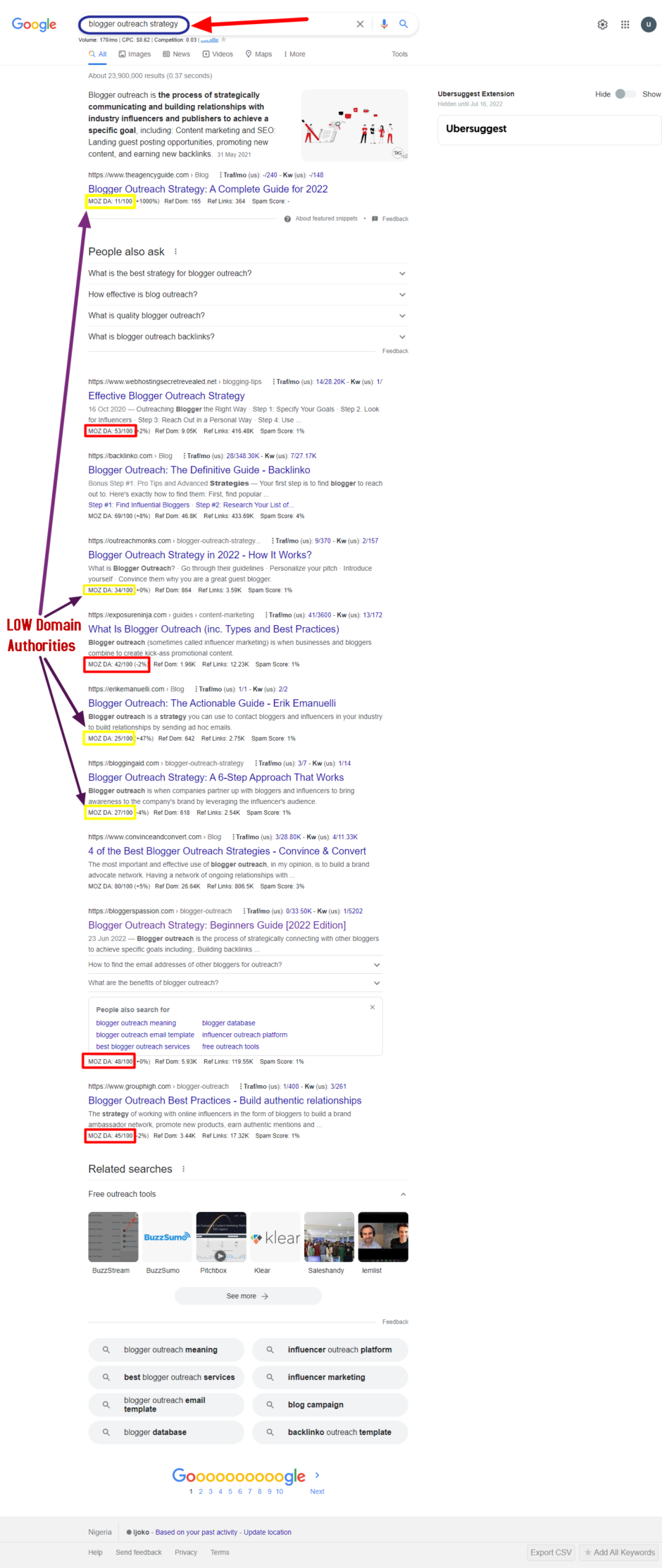
So how do we analyze these competitors?
we look at these 2 important ways.
- check their domain authorities(DAs)
- check their content structure
From these 2, we can search out for loopholes(strength and weakness) to capitalize on to outrank them.
In other words, simply more like finding out what they are doing and replicating their tactics and even more.
FIRST, starting with their domain authorities, a good number of them (in RED box) are of LOW DAs with the first webpage position having a DA of 11 (as its lowest) while the others are of 34, 27, 25.
Hence, to stand a chance, what do we do?
Boost up your Domain Authority as high as 11 and above.
And how do we boost it?
Create High-Quality Backlinks.
The more backlinks you create, the higher your domain authority
SECOND, lets deal with their content structure. when i say content structure, i mean the following;
– are their content long or short?
– are they well spaced with lots of paragraphs for easy reading?
– Do they contain lots of images and videos for easy understanding and illustration?
– are their contents actionable and practicable?
These and more questions are factors to look out for and profit on while creating your own new content to make it seo-friendly, easy-to-read and boost user experience.
For instance, Google search engine favors long-form content(over 3000+ words).
Is your competitor content long? If not, make yours long and even if it is long(say 3000+ words), make yours even longer(say around 5000+).
Also if your competitor content lacks enough images and videos, insert them in yours.
In addition, make your new content actionable by explaining ways of doing things rather than just theory.
Infact, to sum this all up, it is similar to what we call the “skyscraper technique” where you scrutinize high ranking contents, look for loopholes and utilize them to write better contents.
Case-Study Example: Using our case-study keyword search results. the website content occupying top 1st position is long form; over 4500+ words, its words are well spacious with lots of paragraphs, it contains lots of illustrative images for better understanding.
No wonder it ranks on 1st position beating other website with even higher DAs.
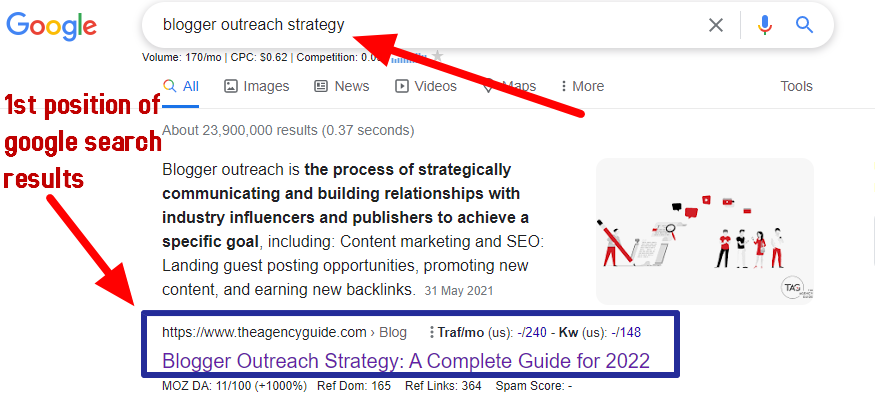
So what do you do here?
Copy and implement the strategies that theagencyguide is using.
If it works for them, it will surely work for you.
As for other webpages on first page search results, you can examine them out if you wish.
Explore ranking opportunities
This shouldn’t take long since we have already analyze the competitors and even talked about its opportunities to explore to rank high like them.
But we will just expand a bit further.
We will take a critical look at majority of the competitor websites and fish out likely opportunities beginning with the competitor webpage occupying the first position: theagencyguide
We will look into just 5 of them all.
FIRST COMPETITOR(theagencyguide): From my observation, i must say that this is the perfect site to copy in matters of engaging readers, being friendly with SEO, boosting user experience etc.
That is why despite its LOW DA=11, it is ranking first position, way above others with even higher Domain authorities.
Not surprising to me anyway.
So, what exactly do we replicate from the first competitor?
Everything.
- agencyguide is 4457 words(check here by copying and pasting their content). Make yours longer, say 5000+ words.
- just like them, make your content very well spacious with lots of paragraphs for easy reading.
- just like them, add lots of illustrative images to buttress every of your points
- they don’t have any videos. capitalize on this by embedding 1 or 2 videos from YouTube.
- they have a DA of 11. Try boost your DA past 11+
Lets check the 2nd competitor
2ND COMPETITOR(webhostingsecretrevealed): lets scan the 2nd competitor to see what we have up our sleeves.
- it is just 1892 words. write more than that
- emphasize your steps with lots of illustrative images.
- include videos. they don’t have any in theirs
- try boost you DA to above 53. theirs is 53.
- unlike theirs, state how to execute each steps in action.
Yes, it is NOT going to be easy. That i know especially boosting your DA, but gradually one step at a time, you will get there.
3RD COMPETITOR(backlinko) is a very strong authority in the digital marketing niche with high DA so it will almost be impossible to outrank it for now or in the nearest future.
That is why we didn’t consider it as our competitor of interest.
Lets move on to the fourth
4TH COMPETITOR(outreachmonks): Now i see why this competitor is ranking on the 4th position after careful analysis and it might be due to the following reasons;
– Its steps listed are not stated in actionable terms
– the content seems somehow clumsy(not well spacious)
– no much images to illustrate points
– it is only 2218 words.
These are loopholes that you can take advantage of if you hope to rank higher than outreachmonks. So at this point, you already know what to do.
5th COMPETITOR(exposureninja): Take a brief moment and scroll through the content from top to bottom.
Even an unborn baby will strongly observe that something serious is conspicuously missing in this article content.
It is just more like a bunch of text words separated by headings topics. I mean No illustrative images, no enough paragraphs, no step-by-step actionable practices, nothing spectacular.
And to crown it all, it is just about 1,600 words count.
While it is ranking on first page maybe probably because it has a good Domain authority of 42.
If not, it has no business being on that page in the first place.
But hey, its all left to the big G itself to decide.
Finally, in a nutshell, judging from the analysis of the top 3 competitors, we can definitely armed with the right tips, tactics and techniques to replicate their winning game plan and even enhance better than them.
Do Content Optimization
Picture this scenario
You moved into a neighborhood and noticed that your co-tenants own exotic cars.
So to stand out, you refurbish your new car only to discover that its engine is completely bad/need repairs.
How would you feel?

Infact, what is even the essence of upgrading your car in the first place?
Same way it applies to content.
To achieve guaranteed search engine ranking, it not only includes serp analyzing your competitors(upgrading your car features) but also optimizing your content too(making sure its engine is working perfectly), hence the process called content optimization.
So, what is content optimization?
It is the process of making your content stand the best chance of meeting its set-goals and in this case, getting higher search engine rankings and more visibility on the web.
Infact, content optimization is a very integral part of search engine optimization where online businesses can generate organic traffic, boost sales, gather leads etc. via its website, videos, images rankings on search engine.
So, we will discuss various strategies on how you can optimize your content for SEO and meet your targets as they are listed below;
Content Optimization Strategies for SEO
- Research the right keywords
- Including relevant keywords in the URL
- write compelling meta description
- Optimize page title
- optimizing your images
- Use headings(head tags H1, H2, H3 etc.)
- Do internal link building
These tips are so big enough that they can generate big topics on their own but for brevity sake, lets discuss them one by one below;
Research the right keywords
we have already discussed about keyword research already above as one of our steps towards serp analysis but we will discuss some important notes on it.
Competition
Nowadays, the internet space is becoming saturated with lots of contents competing for various keywords making competition very stiff.
So how do we compete in such a situation?
Enter: Go for low competition keywords.
Though they might be of low search volume but the chances of getting conversions is very high e.g. making sales, gathering leads, getting clicks etc. and also guaranteed almost 100%.
To fish out these set of keywords, there are several tools to help you out: Ahrefs, keywordeverywhere and my favorite: Semrush.
The procedure on how to use these tools are already discussed above.
Search intent
what exactly are online visitors looking for when they use your keywords?
What is their intent for using that keyword?
- Is it to buy something
- Is it to know more about something?
- Is it to visit a website/webpage?
- Is it to get information about a product or service?
- Or what?
In combination with your keyword search results, these questions will help guide you on the kind of answers to offer for your target keywords.
For example, when a visitor googles “infinix note 12 latest”, he is most likely wishing to buy the phone right away or later.
To get more info about your keyword as it relates to intent, scroll up to my “keyword research” step above.
Keyword Difficulty
Using keyword tools, you must check how difficulty, moderate or easy your keywords is.
why?
Because it determines your chances of getting higher google rankings for such keyword. The higher the difficulty level, the tough it is to rank and vide versa.
For example, the lower the KD(from 50% and below), the easier the keyword is
So go for keywords of low difficulty.
Include relevant keyword in URL
Google is no magician.
How will it(Google) be able to fish out millions of results from its index for its query keyword if not through their URLs?.
Using our case-study keyword: “blogger outreach strategy“, a good example is as shown below;

From above, you can see that the link: https://outreachmonks.com/blogger-outreach-strategy-how-it-works/ contains the keyword in full.
So it is a simple and straight forward process: Once you are done creating your content, edit the URL Slug by inserting your keyword in the permalink section of the post settings.
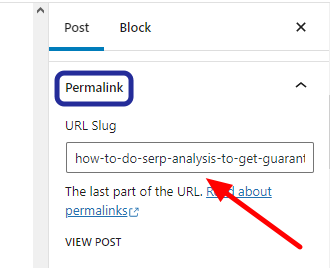
Write compelling meta description
When you view keyword search results, the piece of text you see below the blue text link is meta description.
Its purpose is to give us a glance of what the main content is all about.
How can you take advantage of this description?
Simple!
By writing it in a way to persuade the searcher to click through to your site.
And while writing such description, make sure you include your keywords within it as you can see in the image below;
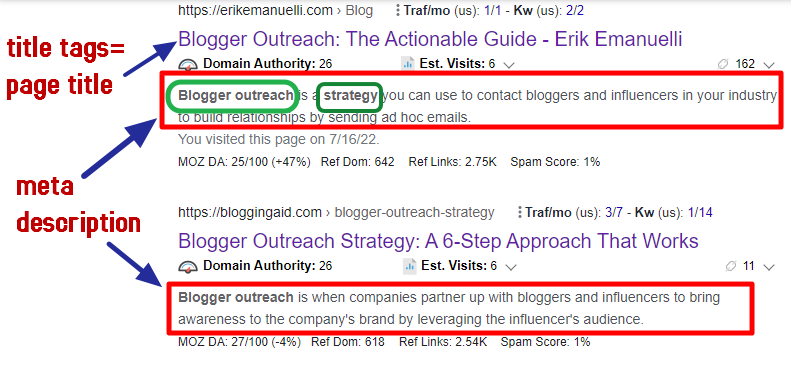
Such meta descriptions are within 120-160 word characters in length(it varies) and be in form of definitions(as shown above), curious questions, general statements, tips etc. In whatever form, just make it as attractive as possible.
Optimize your page title tags
Page title = MAIN Topic of a webpage content
Being the main topic of a content, they are meant to remind online visitors about what your content is about.
To understand what page title looks like, check out this 2 images below;
This first image below shows page title in form of blue link in search engine results;

While this second image shows another page title in an internet browser tab as indicated below;
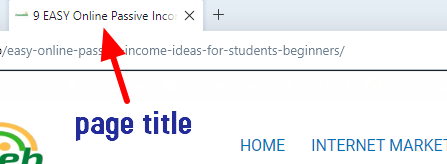
These 2 images is to point out the 2 prominent locations where you can identify page title for a particular webpage:
- Search page results
- Web browser tabs
In addition to these locations, such page title are the first to be setup at the very start of writing your content at a specific point signifying “Add title” as shown below;

But knowing its purpose, locations and its mode of setup aren’t enough.
What is key is its impact in SEO optimization and it all boils down to this simple but technical question below;
How can it be constructed to generate clicks?
Why clicks?
If Google search engine observes that a particular webpage is receiving more attention(clicks and visits) than others, it pushes it higher in its search rankings.
Hence, click is a very important ranking factor.
IMPORTANT NOTE: Remember that you are in a tough competition with other webpages in google search results so this is very paramount if you want to get considerable amount of organic traffic from google.
So, to answer this technical question, these following strategies below will aid us out in getting clicks;
Include Keyword In Page Title
While creating your page title, insert your keyword in because it is one method google uses to fetch out webpage results that relates to that keyword.
For example, take a look at out case-study keyword below;
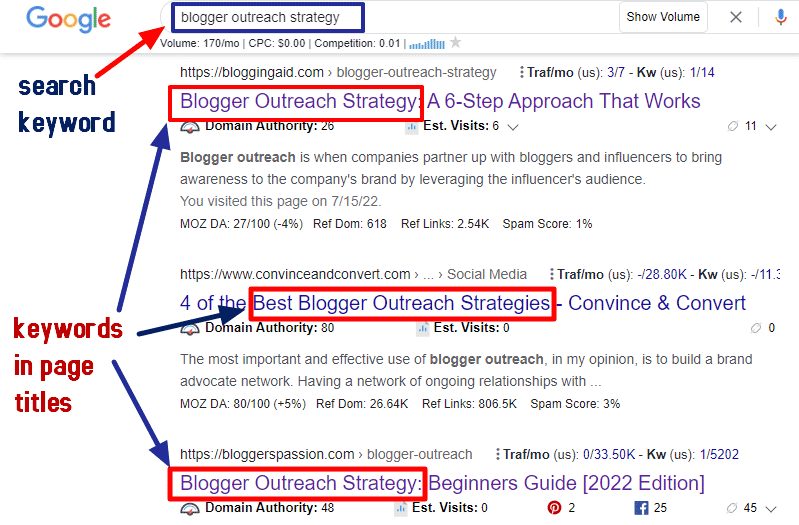
you will observe that each webpage results contains all or most of the keywords.
Special Trick: To stand a better chance of ranking high above your competitors, start your page title with your target keyword FIRST.
As you can see above, the 1st and 3rd webpage results are good examples.
Keep titles about 55-60 characters long
Imagine you research a keyword: “affordable seo services” on google and see something like this;

what will be your next action?
.
.
.
Sure, it will be to scroll pass to the next result.
And what does this entails at the end?
Drop in clicks.
And when nobody clicks your webpage link, google will drop your link down to page 2.
That is why it is highly recommended that you make your page title as short, concise and fully-descriptive.
And keep it within 55-60 characters long.
Insert your company name or brand
While creating your page title, including your brand name especially if you are well known in your niche industry.
A good example is brain dean of backlinko. he is an SEO expert in the world of digital marketing.

In fact, if you know the extent of impact he has made, seeing him alone will compel you to check his post out.
Keep it simple and to the point
No beating about the bush.
Make your page title concise, precise, short, sweet and straight to the point. Let your title pass the message directly and summarily about what your content is about.
See an example below;

Just 8 words is enough for it to tell us what to expect if we open the link and read its content.
Include numbers where necessary
When i say numbers, i mean counts and years. Below are few examples;
–13 seo tips that works,
– How to do on-page SEO [year 2022],
– On-page SEO: 7 factors to implement in year 2022
Infact a study research conducted by brain dean proves that page titles with numbers appears more on 1st page rankings than pages without numbers.
Why?
Because internet searchers are more compelled to visit list posts because they feel it offers them the information they are looking for quicker, faster and to the point.
For example, do a google search of this keyword: “how to get traffic to your website” you will observe that majority of the search results are List Posts: they contain numbers.
So here is what you can do; Make majority of your website posts, list contents
Use Enticing words
Powerful, Amazing, Easy but powerful, Extraordinary, Super, Remarkable, Sales end soon, Essential, Quick, Challenge, only 3 left, limited offer, Suddenly, Now, Instant, Free, Ultimate etc.
These are power words that invoke emotions, hook them in and subconsciously urge you to click on.
As you can see below, it is abundantly used in these webpage search results;
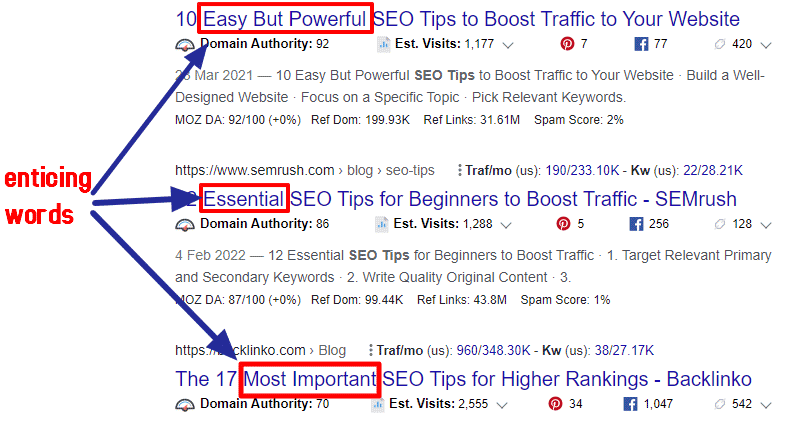
So what is preventing you from doing the same?
Special Note: while using these words, make sure it reflects what’s in your content. you cant use the word: “Most important” and write a mediocre article. you just cant.
Optimize your images
No much writeup on this. it is simply renaming your images before uploading them onto your content and it is done in 2 ways;
– renaming your image directly. For example, changing your image name from image00001x1.jpg to blogger outreach strategy.jpg
– adding Alternate text in its Alt text box. e.g. strategies for effective blogger outreach.
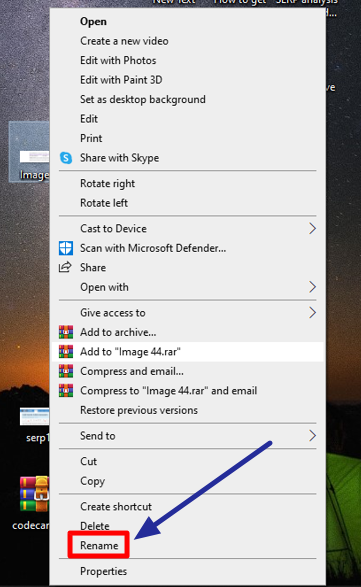
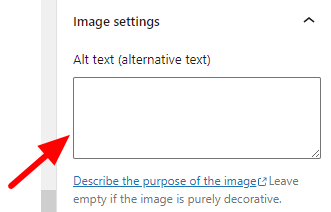
Why carry out this 2 actions?
Because when online visitors are searching for images to use, search engines make use of its names and alt. text to produce image search results for specific keyword queries.
Use Header Tags
Header tags are headings used to represent topics and sub-topics and they must be used for 2 obvious reasons;
- They break contents into various sections for easy readability and depth
- Search engines use them to navigate your content and understand what its about.
And in addition, you can include your keywords in such header topics and subtopics for SEO purposes. I have even implemented this header strategy in this very content you are reading as shown below;

One sure way to insert such header topics while writing your content is through the article settings via the following steps;
- first, clicking the “p” sign in the writeup settings, then click “heading”

- Secondly, select the desired header tag (depending though)
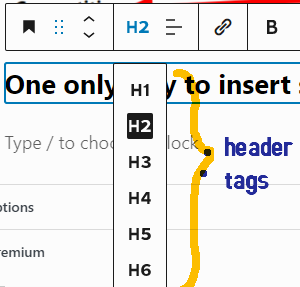
Do Internal link building
From the word “internal”, it means within a confined entity.
Hence, relating it to link building, it simply means links interconnecting inner webpages together within a website. For example, an anchor text “getting traffic visitors” on a particular webpage linking to another webpage with link topic: 30 ways to generate traffic visitors.
I hope you understand?
If you have any questions so far, hit me up in the comments section.
Internal link building is becoming a crucial part of SEO due to the following reasons;
- just like external backlinks, it passes link juice from one webpage to another especially if the former is a power page(one with high quality backlinks and organic traffic).
- It makes the job of crawling and indexing very easy for search engines. In other words, webpages are easily discovered and indexed through its internal links it crawls through.
below image is me linking my anchor text: “make you a millionaire online” to my webpage on this topic on ways to become a millionaire online
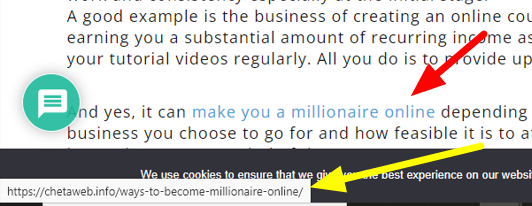
So, what else are you waiting for?
Insert as many internal links as possible within your various webpages right away.
FINAL THOUGHTS: 8 Steps To Do SERP Analysis For Guaranteed Search Engine Rankings
It is at this junction that we draw the curtain on this article.
But before i leave, please spare me some minutes of your time as i share some important tips as well as clarify some issues as regards this discussions so far.
First, if you observe the topic of this article: “Serp analysis for guaranteed search engine rankings“.
It contains the word: guaranteed as it regards to rankings which has generated arguments among seo experts, webmasters, bloggers, seo service agencies etc.
What really makes it very controversial?
It is because there are claims that no position in search engine rankings can be assured.
And even Google itself has stated that it is almost impossible for any individual or SEO agency to guarantee any position in its rankings maybe due to numerous factors involved.
Addressing this issue right now will prolong this article furthermore but no worries for i have written a comprehensive article where i have trashed the issue extensively to the bone here: is it possible to guarantee google first page?
Secondly, After carrying out this serp analysis, the resultant effect isn’t a quick fix. Yes, there is every reason for you to achieve higher search rankings especially if you are targeting very low competitive keywords and depending on the niche you are operating within.
The issue here is the time; maybe within 3 months, 6 months, a year or even few weeks.
But my point is this; it will take much shorter time than it is generally predicted.
Google search engine is unpredictable not necessarily for the negative reasons at the time but for positives as well.
So feel more assured that you will eventually hit the spot. its just a case of time.
Now, over to you….
Are you going to try out this analysis on your existing website?
Do you want to experiment it on your new website?
which step are you facing challenges with?
Do you have any questions about anything related to this topic at all?
Feel free to drop your comments, questions, suggestions, criticisms, analysis and advice
I am 100% available to respond to your comments anytime, anyday.
Thanks for your time, patience, endurance and attention.
Till I see you again in my next post,
Bye for now
